Risk Anticipation and Defensive Driving
Risk Anticipation and Defensive Driving
A. Risk Anticipation
(1) Importance of risk anticipation
- •If the danger that can be created by traffic situation be known before hand, accident can be prevented fundamentally.
- •The driver or pedestrian recognizes the danger on traffic based on experiences or knowledge and make decision on their actions based on their own judgment. However, the other party may act unexpectedly thus you may be prepare for the spontaneous change.
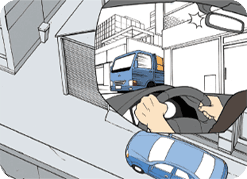
[The risk anticipation may prevent the traffic accident fundamentally]
(2) Technique of risk anticipation (I)
- • Take a quick look at the things and immediately get a grasp of things - Identify
- •Equip with knowledge and experience on various traffic environment and information and on the information of the situation which creates danger by road environment.- Predict
- •Find out the traffic situation and proceed immediately when there is no problem. - Decision
- •The determined action has to be promptly and accurately execute within the required time.- Execute
[The risk anticipation is prepared with the considering the worst situation]
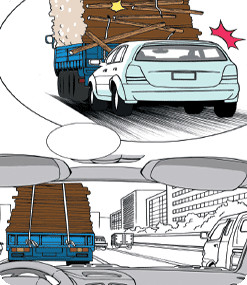
(3) Technique of risk anticipation (II)
- •Danger is always present in places where it is invisible to the driver’s eyes.
- •The driver has to prepare with the worse traffic condition in mind.
- • If the situation is for the driver to violate the traffic laws and regulations, acknowledge that other drivers also refrain from any deviation.
- • The driver has to be clearly visible by other drivers in other words, predictable driving should be practiced.
- • The driver has to watch carefully on the behavior of other car and pedestrian. You should refrain from thinking that others will avoid the risk.
B. Defensive Driving
[Cities have many risk factors that there is a requirement of various ways of defensive driving]
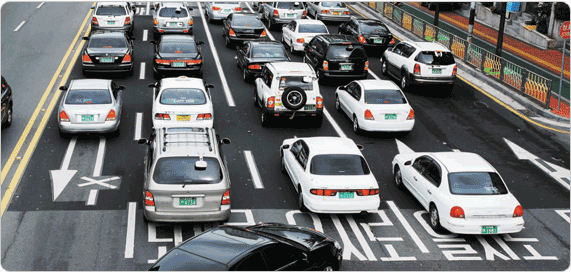
(1) Concept of defensive driving
Defensive driving means the driving to prevent the traffic accident in advance by actively responding to the risk from the dangerous actions of other drivers or pedestrians or worst of weather condition and improper road structure.
(2) Needs of defensive driving
In order to undertake for safe driving, interaction with other drivers are required. Even when a driver complies well with the traffic laws and regulations and practice correct driving, if other drivers are not in compliance with regulation or a pedestrian suddenly jump into the car, an accident is inevitable.
(3) Defensive driving in cities
- • Eliminate the risk factors of traffic
accident
Communicate with other drivers and pedestrians.
Do not make the situation for sudden brake.
Maintain sufficient safety distance for the event that the car in front suddenly steps on the brake, you will not to collide.
When passing the other cars, leave sufficient distance for it is to safe in case when other car to makes sudden lane change.
When driving the road with traffic jam, there may be a car that cross the center lane to pass, thus when drive on 2-lane road to stay further away from the center lane and when drive on 4-lane road stay on the right lane if possible. - •Make a habit of yielding and having
consideration for others
When a child, elderly or disabled person is around, make sure to slow down or stop to protect them.
When passing the signal-less intersection, yield and drive regardless of right-of-way.
When there is a car for changing lane or cutting in, reduce the speed and provide sufficient space and when a large vehicle cuts in, yield immediately.
When a car approaches from behind, step on brake lightly, and when the car behind attempts to pass, take the right side road or slow down to let it pass.
(4) Defensive driving on the rural roads
- • When a low speed vehicle (farm machine, cargo truck or others) is ahead, do not pass on curve, uphill or downhill.
- • Apply the brake to reduce the speed. Use the horn and the brake at the same time to turn the handle to the right as much as possible. Do not give up to the moment of collision, and handle the steering wheel and the brake as much as possible to avoid the collision.
- • The road may have wild animal or trees and bushes that may interfere the vision of the driver thus carefully proceed with focused vision to the front and pay special attention.
(2) Technique of risk anticipation (I)
- • Take a quick look at the things and immediately get a grasp of things - Identify
- •Equip with knowledge and experience on various traffic environment and information and on the information of the situation which creates danger by road environment.- Predict
- •Find out the traffic situation and proceed immediately when there is no problem. - Decision
- •The determined action has to be promptly and accurately execute within the required time.- Execute
(5) Defensive driving on expressway
- • Search for cars and road blocks of front road for 20~30 seconds.
- • When making lane change or entering or exiting, the intent of the driver has to be clearly shown.
- • Drive in the position where large cars do not block the visibility from the front or side.
- • When driving in fast speed for long time, the attention span is lowered that resting is required for certain hours (Shoulder area is not a resting place).
(6) Defensive driving following the climate condition
- • to the climate condition (rain, snow or fog) that the driver cannot see clearly for road and other cars, it is hard to notice the other driver or secure the view. Therefore, the light system of the car is used to inform the location to the other drivers.
- •Slowing down under snow, rain and fog would be the only way for safe driving.
- •Sufficient safe distance has to be secured compared to the normal driving situation.
- •Prepare to take action for sudden action of the other cars.
(7) Defensive driving at night and passing tunnel
When driving at night and in tunnel, the visibility of driver becomes narrow and the speed sense is decreases. Therefore, the driver confirms the driving speed with the odometer, and particular attention shall be paid to secure the safe distance. On the intersection and curved or uphill of rural road in the regional location, use the light, emergency light and others to let other know of your position.
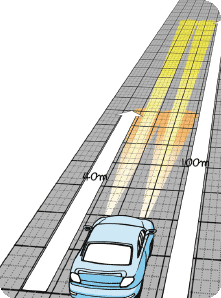

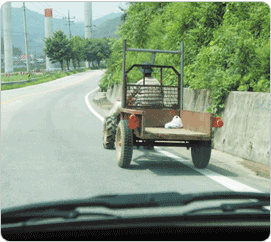
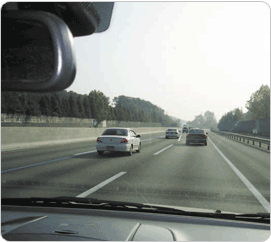
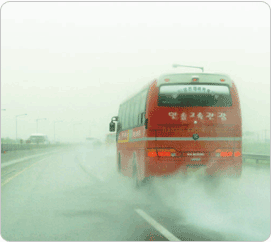
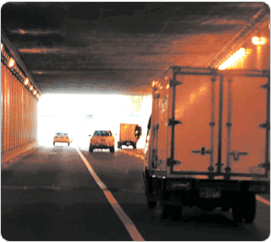
 Copyright © 2018 KoROAD. All rights Reserved.
Copyright © 2018 KoROAD. All rights Reserved.